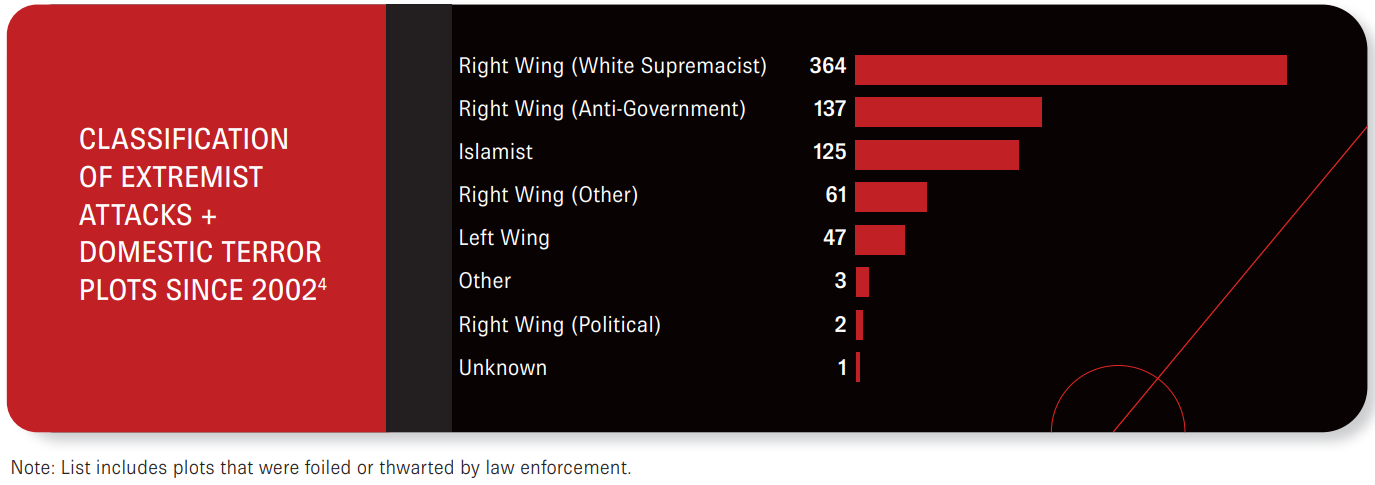Can your General Liability policy truly protect your clients in today’s volatile environment? As domestic terrorism threats rise and A&B exclusions grow, insureds face increasing exposure to nuclear verdicts. Learn why private market terrorism policies offer the clarity and certainty your clients need in an era of evolving risk.
Recently, acts of violence in California and Washington, D.C. — both carried out by U.S. citizens with documented ideologies — have raised serious questions about risk classification, insurance coverage, and legal exposure. While these events meet the criteria for domestic terrorism, the U.S. federal government currently lacks a criminal statute to formally charge individuals with domestic terrorism.1
THE REALITY OF DOMESTIC TERRORISM
Consider the 1995 Oklahoma City bombing by Timothy McVeigh — still the deadliest domestic terrorist act in U.S. history. Despite the scale of the attack, McVeigh was not charged with terrorism but with criminal offenses, including the use of a weapon of mass destruction and multiple counts of murder.
Although that event occurred nearly 30 years ago, the threat has only intensified. Between 2001 and 2021, more than 540 domestic terrorism incidents were reported in the U.S., with federal investigations into such activity increasing by 357% over the past decade.2
THE INSURANCE ANGLE: WHY IT MATTERS NOW
The growing concern among casualty insurers centers around rising nuclear verdicts in Assault & Battery (A&B) cases. Businesses — from apartment complexes and bars to hospitals and retailers — have been found liable when patrons, employees, or even bystanders are injured during violent incidents. Even more troubling, in some cases, family members of perpetrators have received multimillion-dollar awards.

A CLASH BETWEEN INSURERS + LENDERS
This has prompted many insurers to exclude A&B from General Liability (GL) coverage altogether. In response, lenders are increasingly mandating that GL policies include A&B coverage without sublimits, further complicating placement for insureds.
RISING TRIA COSTS, LIMITED PROTECTION
To bridge the gap, some insureds have turned to TRIA (Terrorism Risk Insurance Act) endorsements. However, the premiums for TRIA coverage are surging — in some cases reaching 100% of the GL premium. TRIA also requires the federal government to certify an event, a process that adds uncertainty and rarely includes domestic incidents.
GROWING CORPORATE TARGETS
Many businesses today face organized opposition, whether ideological, political, or religious. While free speech is constitutionally protected, escalation to violence often results in litigation, particularly when U.S. citizens are involved. The legal system views such actions as crimes, not terrorism, exposing companies to liability without the shield of TRIA or GL coverage.

PRIVATE MARKET TERRORISM COVERAGE: A CLEARER SOLUTION
Private-market terrorism policies differ fundamentally. They do not distinguish between international and domestic acts of terrorism, nor do they require government certification. This ensures coverage is triggered promptly and GL coverage is preserved, providing a vital safety net in uncertain times.
BOTTOM LINE
Historically, terror attacks on U.S. soil prompted national outrage and swift responses. But in today’s polarized climate, where corporate actions are under constant scrutiny and negligence theories are expanding, the same legal strategies used in A&B litigation may soon apply to domestic terrorism-related claims.
In this environment, relying solely on a traditional GL policy is increasingly risky. A private market terrorism policy offers clearer protection, streamlined response, and greater peace of mind for insureds navigating a volatile world. Reach out to your CRC Group Producer today to learn more.
CONTRIBUTORS
- Chris Kirby is President of Starwind Specialty’s Political Violence & Terrorism (PVT) Program.
ABOUT STARWIND PVT
With over 30 years of underwriting experience, Starwind PVT brings unmatched expertise and product innovation to a complex, evolving risk landscape requiring comprehensive, client-specific solutions. Learn more here.
END NOTES
- Understanding and Conceptualizing Domestic Terrorism: Issues for Congress – www.congress.gov/crs-product/R47885
- The Rising Threat of Domestic Terrorism in the U.S. and Federal Efforts to Combat It, U.S. GAO, March 2, 2023. https://www.gao.gov/blog/rising-threat-domestic-terrorism-u.s.-and-federal-efforts-combat-it
- What Are Nuclear Verdicts?, U.S. Chamber of Commerce Institute for Legal Reform, June 26, 2024. https://instituteforlegalreform.com/blog/what-are-nuclear-verdicts/
- ‘A perfect storm’: Extremism online and political polarization are increasing the risk of attacks, experts say, NBC News, January 4, 2025. https://www.nbcnews.com/investigations/online-extremism-political-polarization-us-attacks-threat-rcna186017